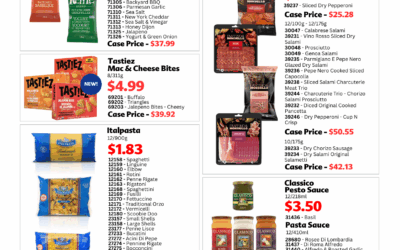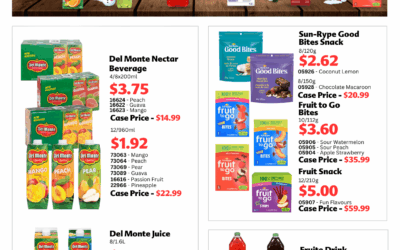As a wholesale distribution company, understanding the intricacies of seasonal fluctuations in food demand is important to maintaining a competitive edge in the market. From the bountiful harvests of summer to the cozy comforts of winter, each season brings its own unique set of challenges and opportunities for wholesalers. In this blog post, let’s talk about the nuances of seasonal fluctuations in wholesale food demand, offering insights and strategies to help distributors navigate through the highs and lows of the market.
The Dynamics of Seasonal Demand
Seasonal fluctuations in food demand are driven by many different factors, including climate, cultural traditions, holidays, and consumer preferences. For wholesalers, this means that the demand for certain food products can vary significantly throughout the year. For example, during the summer months, there is typically a surge in demand for fresh produce, barbecue essentials, and beverages, as consumers embrace outdoor gatherings and picnics. On the other hand, the winter season sees an increased demand for hearty comfort foods, holiday specialties, and warm beverages to combat the cold.
Anticipating and Planning for Seasonal Shifts
To effectively manage seasonal fluctuations in demand, wholesale distributors must adopt a proactive approach to planning and forecasting. This involves analyzing historical sales data, monitoring market trends, and collaborating closely with suppliers and customers to anticipate shifts in demand ahead of time. By identifying patterns and seasonality trends, wholesalers can adjust their inventory levels, procurement strategies, and marketing efforts accordingly to capitalize on opportunities and mitigate risks.
Leveraging Technology and Data Analytics
In today’s digital age, technology plays a crucial role in helping wholesalers navigate seasonal fluctuations in demand. Advanced data analytics tools can provide valuable insights into consumer behavior, demand patterns, and market trends, enabling wholesalers to make data-driven decisions in real-time. By leveraging technology solutions such as inventory management systems, demand forecasting software, and online sales platforms, wholesalers can optimize their operations, streamline processes, and better serve their customers year-round.
Diversification and Flexibility
In addition to planning ahead, diversification and flexibility are key strategies for wholesalers to adapt to seasonal fluctuations. Diversifying product offerings to cater to different seasonal demands can help mitigate the impact of fluctuations in any single product category. For instance, a distributor specializing in fresh produce may also carry a range of shelf-stable pantry staples or seasonal specialty items to maintain a steady revenue stream throughout the year. Furthermore, maintaining flexibility in sourcing and distribution channels allows wholesalers to quickly adjust to changing market conditions and customer preferences.
Building Strong Relationships
Last but not least, building strong relationships with both suppliers and customers is essential for wholesalers to effectively manage seasonal fluctuations in demand. By fostering open communication and collaboration, wholesalers can work closely with suppliers to secure reliable sources of supply, negotiate favorable terms, and access seasonal products in high demand. Likewise, maintaining strong relationships with customers allows wholesalers to understand their needs and preferences, provide personalized solutions, and build loyalty over time.
Understanding and adapting to seasonal fluctuations isn’t just about meeting demand—it’s about positioning your wholesale distribution company as a trusted partner that anticipates and fulfills the needs of customers, no matter the season. By adopting a proactive approach to planning, diversifying product offerings, leveraging technology, and building strong relationships, wholesalers can successfully navigate the highs and lows of seasonal demand, ensuring sustainable growth and profitability in the long run. Embracing flexibility, agility, and innovation will be key in staying ahead of the curve and delivering value to customers throughout the year.










